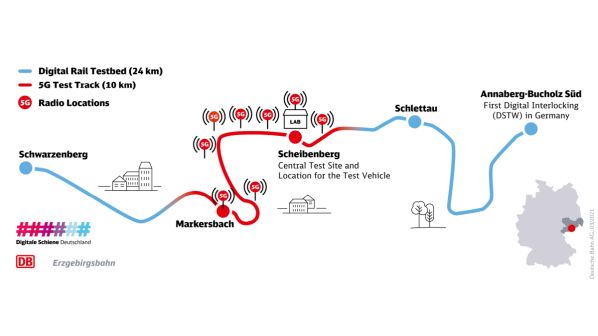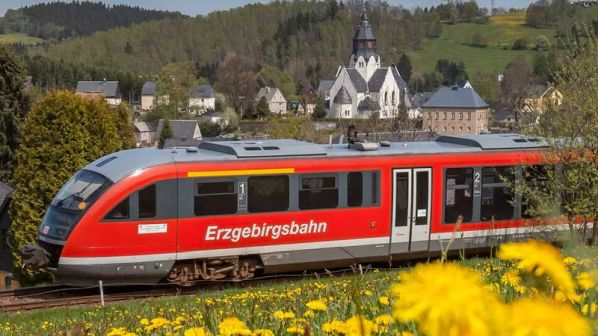GERMAN Rail’s (DB) Digital Rail Germany (DSD) project announced it has achieved a major milestone in the installation and testing of a 5G-based communication network to test the Future Railway Mobile Communication System (FRMCS), after a Mission-Critical Push-to-Talk (MCPTT) call was successfully made over a newly built 5G stand-alone cellular network.
The FRMCS test network is being built by DSB, Nokia and Kontron Transportation on the Annaberg-Buchholz - Schwarzenberg line in Germany’s Ore Mountains. Installation of the FRMCS test system began at the end of 2021, with the MCPTT call successfully made on February 23. DSD says the call demonstrates the successful integration of the different components, which means FRMCS can now be tested for the first time in a live system.
FRMCS is composed of the “transport stratum” and the “service stratum.” The transport stratum is realised via 5G and forms the transmission layer for the service stratum, which itself is implemented via the 3GPP Mission Critical Services (MCx) framework. The MCx framework provides additional functionalities, such as for authentication, group calls and video transmission, which are needed by existing and future railway applications such as automated driving or artificial intelligence (AI) based traffic management.
Nokia is providing the 5G technology for DSD’s Digital Rail testbed, while Kontron Transportation is implementing the MCx services. Both solutions are based on the current 3GPP Release 16 mobile communications standard.
Nokia is using 5G Airscale Radio components for the radio interface, the 5G Stand-Alone Cloud Packet Core for the communication network, and components for connecting and synchronising all network elements. Remote radio heads and antennas with a 4x2 MIMO configuration have been installed at the radio sites along the test track and on the roof of Scheibenberg station, which allows the signals to be better focused in the desired direction and means two data streams can be transmitted in parallel.

A lab at Scheibenberg station houses the central network control, components to modulate the signals towards the antennas, known as radio Base Band Units, and a network service and test platform to support future test campaigns. All components can also be accessed remotely for operation and monitoring.
Several railways are already using the MCx solution supplied by Kontron Transportation. It includes a central component for implementing voice services and an additional server for the realisation of further, data-based applications. The Kontron solution also includes smartphones with a specific MCx application and an application for dispatcher functions.
DB Network is providing the test track and has installed eight radio sites along a 10km section between Scheibenberg and Markersbach, along with masts and fibre optic connections, as well as a site for the server infrastructure in Scheibenberg station.
Following the successful completion of the MCPTT call, the FRMCS test system will be expanded both spatially and technically in the coming months. Additional locations for antennas will be set up and put into operation and further equipment will be integrated, especially onboard trains. The existing equipment will also be gradually supplemented with further functionalities.
Over the coming years, the test field will then be used for further FRMCS trials, such as the testing of so-called hybrid network architectures in which a public mobile network serves as a fallback layer or as a capacity complement to the railway’s own mobile network. New applications of the automated rail system based on FRMCS will be tested in the future, including through the Europe’s Rail research initiative. The tests will likely include the evaluation of an evolved ETCS Level 3 system with hybrid moving block, which is based on a novel safety architecture and allows trains to run at optimal distance, increasing capacity.

